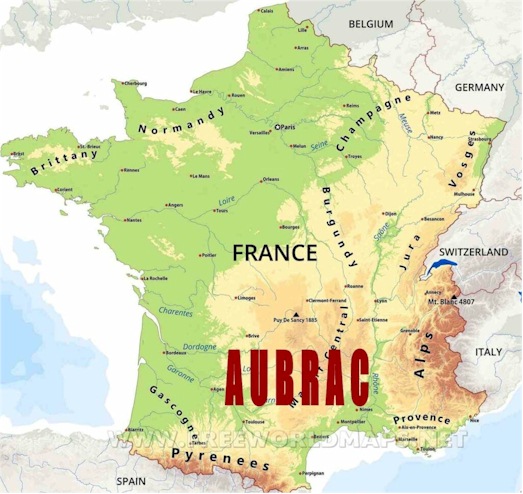No products in the cart.
A STRONG PEDIGREE
BREED HISTORY


The Aubrac cattle breed are quite an old breed of French cattle that originated in the early 19th century. The originated from the Plateau de l’Aubrac in the Massif Central. This area basically spans a few regions of the Auvergne-Rhone-Alpes and Occitanie in Southern France.
The development of the Aubrac breed started during the 17th century at the Benedictine Abbey of Aubrac, in the South of the Central Massif in France. The Abbey was founded in 1120 by a Dutch Lord, Adalard, who had narrowly escaped death twice in this wooded and remote area during his pilgrimage to Santiago de Compostela. He decided to build a monastery to feed and shelter the thousands of pilgrims walking through the area. The pilgrims were offered a meal made of bread soaked in fresh cheese, called Aligot. The local breed of cows was used to produce the milk then turned into this particular cheese. This breed was selected from then on for its hardiness, ease of management and milking ability. The Aubrac Abbey is situated at an altitude close to 4000 feet. It had thousands of acres of land, including 9000 hectares of pastures, some situated up the mountains, some in the low lands. The herds would walk to the mountain pastures on the 25th of May for the summer, and come back on the 13th of October to the low lands to be housed for the winter. This transhumance still takes place on those dates today. After the French revolution, the lands of the Abbey were offered for sale and split up into individual farms but the management of the pastures remained the same. The herds would spend the summer on the mountains, the cows were milked in the pastures and the cheese (Fourme) made there in a small stone dwelling, the “buron”. The production of a quality cheese and the training and sale of draught bullocks were the main income of these farms. The breed had to produce rich and plentiful milk and be docile. In an effort to produce larger quantities of richer milk, the Brown Swiss breed was introduced but soon abandoned as these animals were not hardy enough for the Aubrac conditions. It is this geographical environment that has given the Aubrac cow the ability to survive and thrive in difficult and challenging conditions. No other breed has been able to deliver the same profit margins in the same conditions. To encourage breeders to aim for quality the first Aubrac show took place in Laguiole on the 25th of September 1830. The breeders were judged on the quality of the cheese they produced and the look of their animals. The shows helped to set the standards of the breed in its colour, appearance and abilities. The Herd-Book was established in April 1894.
At the beginning of the Twentieth Century, the Aubrac breed was widespread in the southern and eastern areas of the Central Massif and even in the Mediterranean regions.
At the close of World War II, the Aubrac breed was seriously affected by the competition with tractors (that replaced the Aubrac oxen) and by the disappearance of the milking activity of the “burons” (a combination of traditional cheese manufacturing and the living quarters of the cowherds, in the mountains).
The crisis period also affected other mixed mountain breeds (Ferrandaise, Mezine). The new prevailing tendency in this era was focused exclusively on productivity. The mixed breeds survived with great difficulty in the face of the attractive yields of the breed that were specialized in the production of milk (Prim’Holstein) or for the production of meat (Limousin, Charolais and Blond d’Aquitaine). After the sixties mixed breeds were a thing of the past. The generalized practise of non-scientific mating, especially with Charolais bulls, was one of the main causes of decrease in the numbers of the Aubrac breed. In addition, life and work in the “burons” was increasingly less compatible with the new ambition of society. Its profitability was increasingly less, especially due to the constant increase of the cost of labour: “While in 1900, the sale of 100kgs of Laguiole cheeses could pay the salary of a caretaker and his family, it was now necessary to sell a ton of cheese to pay the same annual salary”. (Source: Centennial Book of the Aubrac Breed 1894-1994, Page 43)
Unwilling to watch the inexorable disappearance of this breed, and committed to no longer seeing it on the list of extinct species, a group of people convinced of the specific advantages and the superiority of the Aubrac cow in many aspects, decided to undertake the rediscovery of the “Black-eyed beauty”. Their dynamism and motivation resulted in the creation of the Union Aubrac, in 1979. Close to extinction in the seventies, the Aubrac breed began to excite interest, thanks to the implementation of efficient measures applied, starting in 1979. Since then this interest in the acquisition of Aubrac breeding cattle has not ceased.
The breed has won over diverse regions of metropolitan France (Corsica, Massif Central, the southeast and northeast of France) as well as the French overseas departments and territories (Guadalupe, Guyana). This development has also been felt outside of French territory. More than 15 countries have already imported the Aubrac breed and continue to regularly acquire animals, embryos or semen for insemination (Spain, Portugal, Morocco, Italy, Ireland, Great Britain, Belgium, Germany, Switzerland, Lithuania, Russia, Israel, New Zealand, the United States, etc.)
